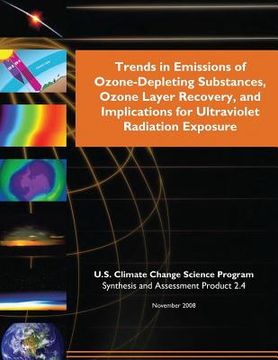Compartir
Trends in Emissions of Ozone-Depleting Substances, Ozone Layer Recovery, and Implications for Ultraviolet Radiation Exposure (SAP 2.4) (en Inglés)
U. S. Climate Change Science Program
(Autor)
·
Createspace Independent Publishing Platform
· Tapa Blanda
Trends in Emissions of Ozone-Depleting Substances, Ozone Layer Recovery, and Implications for Ultraviolet Radiation Exposure (SAP 2.4) (en Inglés) - Program, U. S. Climate Change Science
$ 36.53
$ 50.73
Ahorras: $ 14.21
Elige la lista en la que quieres agregar tu producto o crea una nueva lista
✓ Producto agregado correctamente a la lista de deseos.
Ir a Mis Listas
Origen: Estados Unidos
(Costos de importación incluídos en el precio)
Se enviará desde nuestra bodega entre el
Viernes 19 de Julio y el
Viernes 26 de Julio.
Lo recibirás en cualquier lugar de Internacional entre 1 y 3 días hábiles luego del envío.
Reseña del libro "Trends in Emissions of Ozone-Depleting Substances, Ozone Layer Recovery, and Implications for Ultraviolet Radiation Exposure (SAP 2.4) (en Inglés)"
Depletion of the stratospheric ozone layer by human-produced ozone-depleting substances has been recognized as a global environmental issue for more than three decades. Projections are for a return of ozone-depleting chemicals (compounds containing chlorine and bromine) to their "pre-ozone-depletion" (pre-1980) levels by the middle of this century for the midlatitudes; the polar regions are expected to follow suit within 20 years after that. Since the 1980s, global ozone sustained a depletion of about 5 percent in the midlatitudes of both the Northern Hemisphere and Southern Hemisphere, where most of the Earth's population resides; it is now showing signs of turning the corner towards increasing ozone. The large seasonal depletions in the polar regions are likely to continue over the next decade but are expected to subside over the next few decades. Ozone-depleting substances should have a negligible effect on ozone in all regions beyond 2070, assuming continued compliance with the Montreal Protocol. Large increases in surface ultraviolet (UVB; 280-315 nm) radiation and the associated impacts on human health and ecosystems would likely have occurred if atmospheric abundances of ozone-depleting substances had continued to grow. As a result of the worldwide adherence to the 1987 Montreal Protocol and its Amendments and Adjustments, the large impacts were avoided, and future trends in UVB and UVA (315-400 nm) at the surface are expected to be more influenced by factors other than stratospheric ozone depletion (such as changes in clouds, atmospheric fine particles, and air quality in the lower atmosphere). Emissions of ozone-depleting substances by the United States have been significant throughout the history of the ozone depletion issue. At the same time, the United States has played a leading role in advancing the scientific understanding, leading the international decision making, and leading industry's actions to reduce usage of ozone-depleting substances. Continued future declines in emissions of ozone-depleting substances from the United States, along with those from other nations, will play a key role in ensuring the ozone layer's recovery. Projections of a changing climate have added a new dimension to the issue of the stratospheric ozone layer and its recovery, and scientific knowledge is emerging on the interconnections between these two global issues. Climate change is expected to alter the timing of the recovery of the ozone layer. Ozone-depleting chemicals and ozone depletion are known to influence climate change. The curtailment of the ozone-depleting substances not only helped the ozone layer but also very likely lessened the forcing of climate (i.e., how it alters climate). Climate change and ozone layer depletion are coupled; this has led to new scientific and decision-making challenges. The recovery of the ozone layer will occur in an atmosphere that is different from where we started roughly three decades back. Our scientific understanding of the connections between climate change and ozone layer depletion is at an early but rapidly advancing stage. That topic will remain a focus for the scientific community's efforts over the next few decades. This report, CCSP SAP 2.4, addresses Goal 2 of the CCSP Strategic Plan: Improve quantification of the forces bringing about changes in the Earth's climate and related systems. The Atmospheric Composition chapter of the CCSP Strategic Plan describes a vision to produce a Synthesis and Assessment Product (SAP) on "Trends in emissions of ozone-depleting substances, ozone layer recovery, and implications for ultraviolet radiation (UV) exposure-SAP 2.4." The report provides a synthesis and integration of the current knowledge of the stratospheric ozone layer, ozone-depleting substances, and ultraviolet radiation reaching the Earth's surface.

